Hi everyone! We hope you enjoyed our LIVE Facebook Question and Answer session with our biologist Cassie Volker. We decided to turn that session into a blog, as a permanent resource.
As a refresher, the Wild Dolphin Project was started by Dr. Denise Herzing in 1985. Along with her colleagues, Herzing and the WDP have been studying two species of dolphins in the Bahamas — the bottlenose dolphin and the Atlantic spotted dolphin.
The Atlantic spotted dolphin is our primary study species. They are born without spots and gains spots with age. These spot patterns are unique, like our fingerprints, so no 2 dolphin have the exact same patterns. That’s how we can tell them apart, by tracking their spots over time, as well as any scars, and nicks and notches out of their fins. Our work is non-invasive, which means we do not feed, touch or even tag the animals. We try to study them while letting them remain as wild as possible, hence our motto, “In their world…on their terms”. We have learned a lot about these two species, such as what they eat, and what they like to play with, where they go, how they communicate, and their social relationships.
Some other facts about dolphins before we get started:
- There are 38 species of dolphin that live in the ocean
- 4 species that live in river
- The largest dolphin species is actually the killer whale, or the orca. Orcas and all dolphins are considered toothed whales, or Odontocetes.
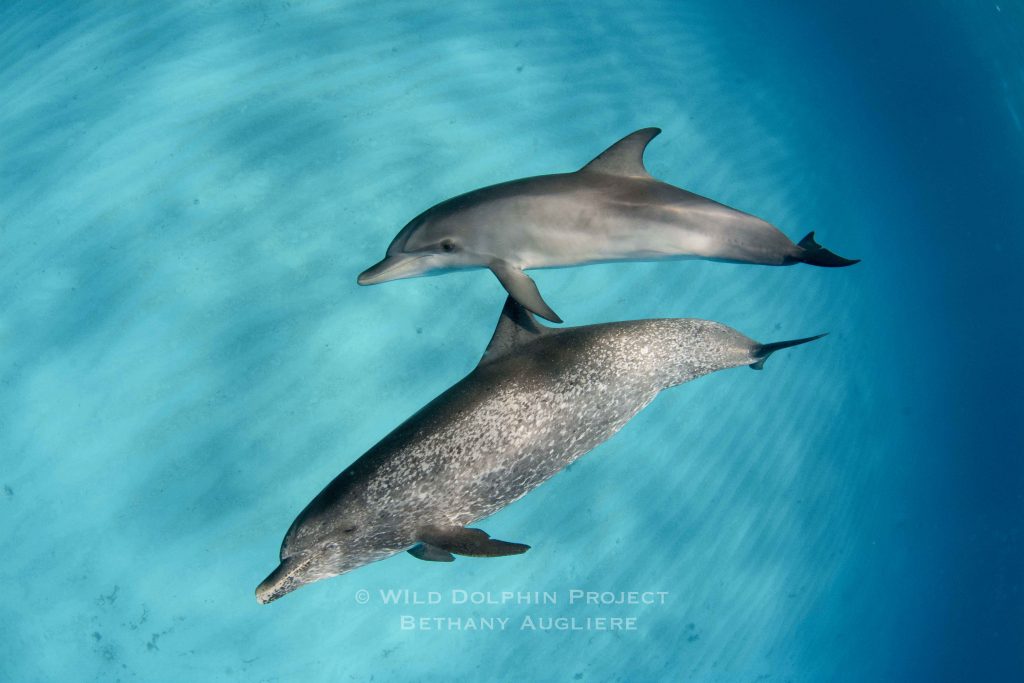
An adult Atlantic spotted dolphin with her calf, who will gain spots with age.
First, how exactly did Cassie become a marine biologist? (This is a common question)
While there are many paths to becoming a biologist, they all have one thing in common: education and experience. Cassie always loved animals, and had a particular interest in why they do what they do. She knew she wanted to study their behavior. She went to Northern Kentucky University for her undergraduate degree in biology, and also did research on how parent birds take care of their babies – in the (Carolina Chickadee). She did this research with the scientist Dr. Lindsey Walters.Gaining research experience as an undergraduate is useful to help define your interests, as well as figure out if you actually like research! It’s definitely important if you decide you want to go to graduate school!
After her undergraduate degree, Cassie knew she wanted to continue with her studies and learn more about animal behavior. She discovered the work of Dr. Denise Herzing and the WDP. Herzing is affiliated with Florida Atlantic University, so she applied and got in. With Herzing as an advisor, Cassie studied the aggressive behavior of Atlantic spotted dolphins. After graduating in 2016, she then went on to work with Herzing as her full-time research assistant. Over the summers (May – September), she’s out in the Bahamas for fieldwork collecting data. The rest of the year she works in the office, managing the database and helping with research.
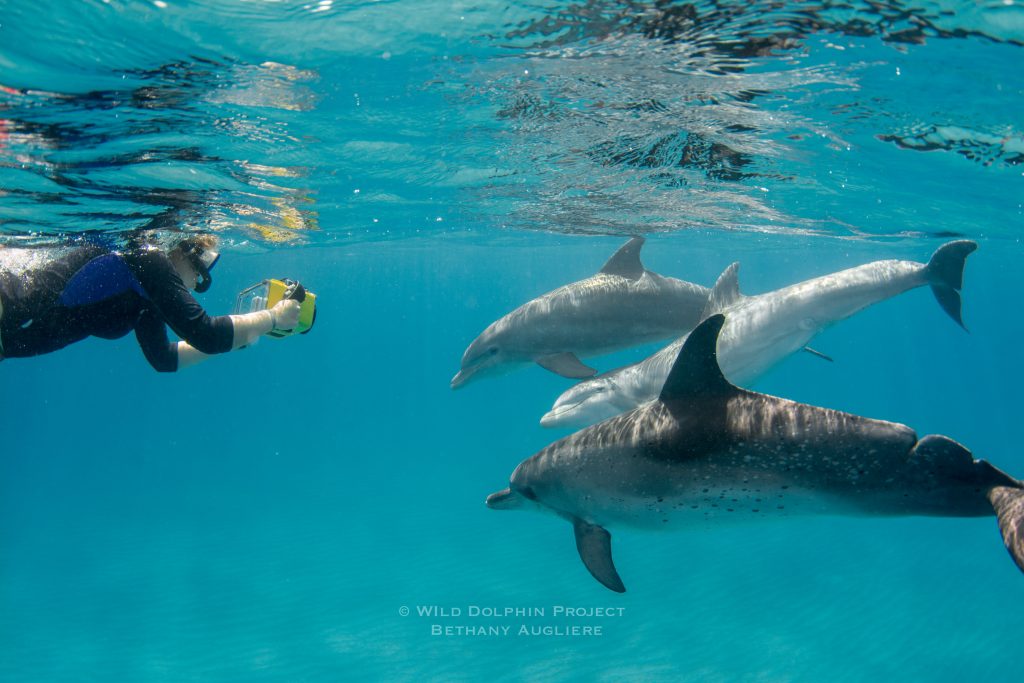
WDP biologist Cassie Volker films two resident species of dolphins in the Bahamas.
How long can dolphins live?
- The spotted dolphins we study in the Bahamas can live to be in their 50’s but the longest most live is between 40 and 50 years old.
- 40-60 years old is average maximum age for many dolphin specie
- One orca female was known to be 90 years old
How big can dolphins grow?
- Bottlenose dolphins reach around 7-13 feet. This is little less than 2 fridges stacked on top of one another.
- Spotted dolphins reach around 5-7.5 feet, which is a little taller than a refrigerator.
- For Killer whales, the largest dolphin species, males reach lengths of 20-26ft with largest recorded at 32 feet. That’s 5 refrigerators stacked on top of one another! Females reach between 16-23 feet.
What do dolphins feel like?
- Generally, they are smooth and feel like a wet rubber boot.
How long do they stay underwater?
- This depends on the species, and where they live. But, for bottlenose dolphins the average time underwater is 8 to 10 minutes, and for the Atlantic spotted dolphin it’s about 2 to 6 minutes.
How deep can they swim?
- Again this depends on the species and where they live. One bottlenose was recorded to dive 990, however it was a Navy trained dolphin. And we know that spotted dolphins can dive up to 200 feet. However, at our study site, which is a shallow sandbank in the Bahamas, bottlenose dolphins regularly dive to about 30-60 feet, and we often find them in water as shallow as 10 feet. The spotteds also generally dive to around 30-40 feet.
How fast do dolphins swim?
- 5 mph is the average swimming speed of a traveling dolphin, which is like a “medium” jog for humans. Once they reach 10 mph they start to leap out of the water to help save energy, but maintain speed. Many dolphins, especially the spotted dolphins in the Bahamas like to surf in the surf in the waves created by boats.
- This is why you also see dolphins swimming on the bow or in the wake of boats, they can catch a free ride to surf and play!
- The fastest recorded swim for a dolphin was 16mph
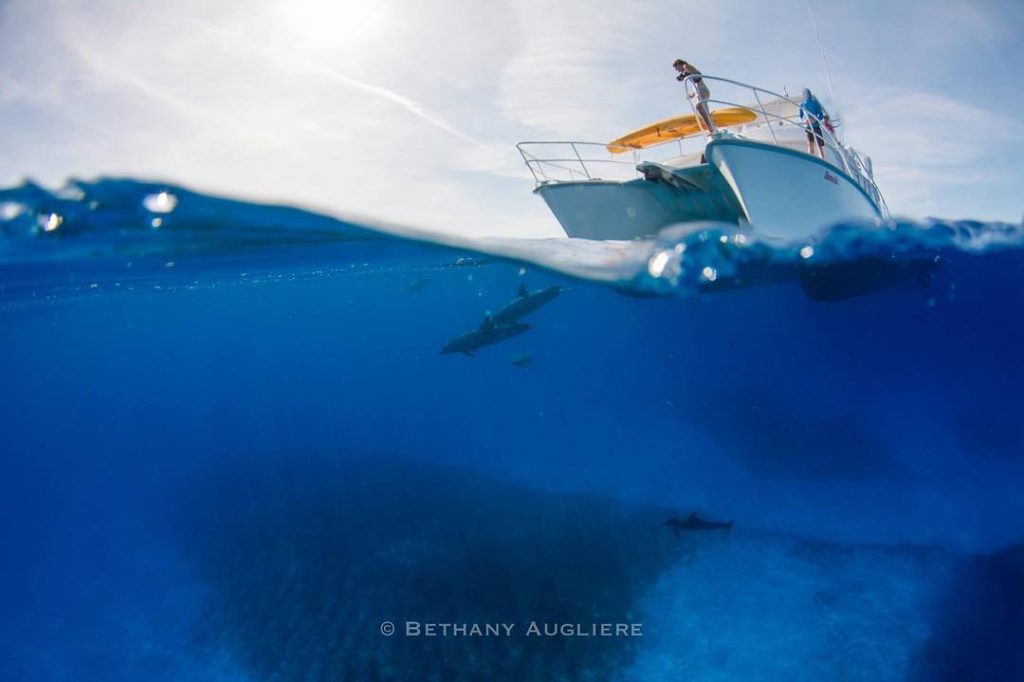
How high can they jump?
- They can jump up to 15 to 30 feet. For comparison, 30 feet is about a 2 story building.

What do they eat for dinner?
- Dolphins are piscivores, which means they are carnivores that eat primarily fish. They also eat squid. In the Bahamas, the spotteds and bottlense to to eat lizardfish, flying fish, flounder, garden eels, and squid.
How many dolphins are in a normal pod?
- This depends on the species. For instance, dolphins like the common dolphins or pantropical spotted dolphins that live in the open ocean over deep water can be in groups upwards of a 1,000 individuals! They need large numbers for protection from predators.
- At our study sites, the population or “community” is about 100 individuals. But within a given day, there are smaller groups (what you might refer to as a pod) that range in size from 2 to 35 animals, based on their social relationships and what they are doing. When they are traveling or fighting, sometimes they are in these larger groups. It’s not uncommon to find a group of 4 or 6 moms with their calves, or a group of about a dozen juveniles or “teenagers.”
- One of the largest encounters we had was a group of 46 dolphins!
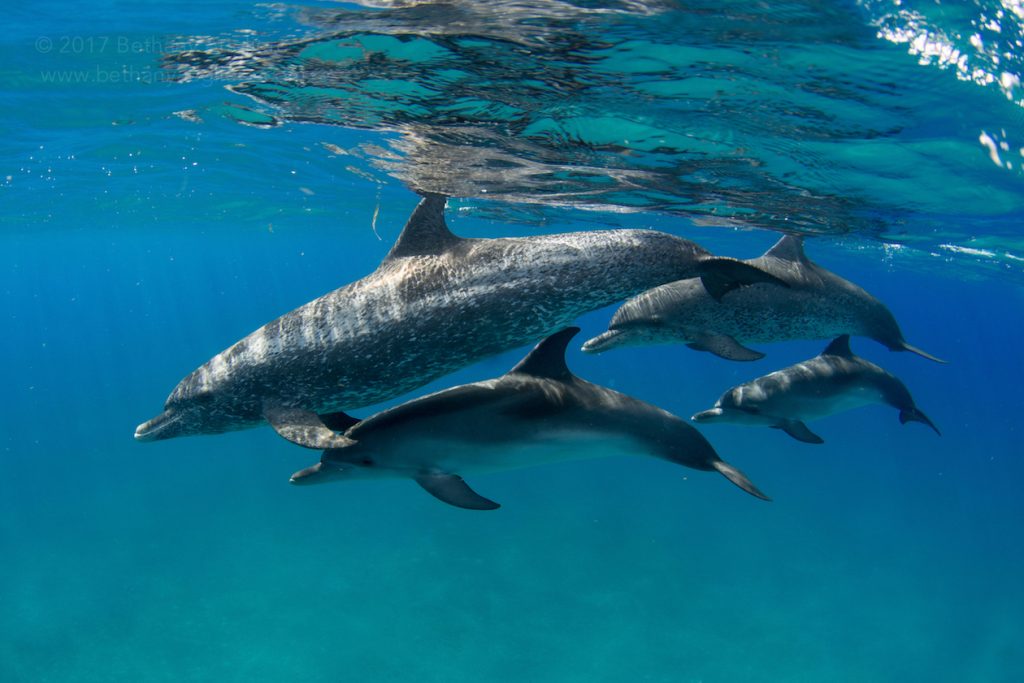
Two adult females travel with their calves.
How long does a baby dolphin stay with it’s mother?
- Dolphins calves stay with their mothers for about 3-4 years depending on when the mom gives birth to another calf. Spotted dolphins are one of the few species that can be pregnant and nurse/lactate at the same time.
Do dolphins alloparent like elephants? This means, do other dolphins aside from the mom take care of a baby?
- Yes they do. We actually had a special case just this past summer where a little female calf seemed to have been separated from her mom. We thought this because every time we saw her, she was being cared for by another adult. Most of the time it was females, but we did see her with one of our adult males on one occasion as well. She was always in the infant position (so right under her caretaker). We really hope she makes it through this summer and we see her in a couple of months.
Do daughters hang out with their moms even after starting own family.
In the Bahamas, spotted dolphins and bottlenose dolphins tend to associate with females associate based on their life stage. So for instance, pregnant females hang out with other pregnant females. Females with calves hang out with other females with calves, and teenagers hang out together. Having said they, older female calves will also hang out with their moms to help babysit and gain practice with calves. Females will also tend to hang out preferentially with their family members. So, if a mom and a daughter both have calves at the same time, we often see them together. This is not uncommon for many dolphin species.
Do the dolphins you have been following recognize any of the members on your research team?
- In Dr. Herzing’s book Dolphin Diaries, she describes how one of the older female dolphins always seemed to do the same behavior when she saw Dr. Herzing in the water, kind of like the dolphin had a special greeting with Dr. Herzing.
- When we released Lamda, the stranded dolphin, back into the wild Cassie was able to be in the ocean during the release. As researchers, we have our big yellow cameras and Cassie thinks he recognized at least the yellow camera on his re-entry into the water. When we first saw him the next season he swam right up to Cassie (who had the yellow camera) and did a really tight circle as if to say- “I remember you, thanks for getting me back to the wild!” Now, whether or not he just recognized the yellow camera or me I can’t say for sure. Dolphins are very intelligent creatures that have long lives and long social relationships, so I do suspect they recognize us in the water, says Cassie.
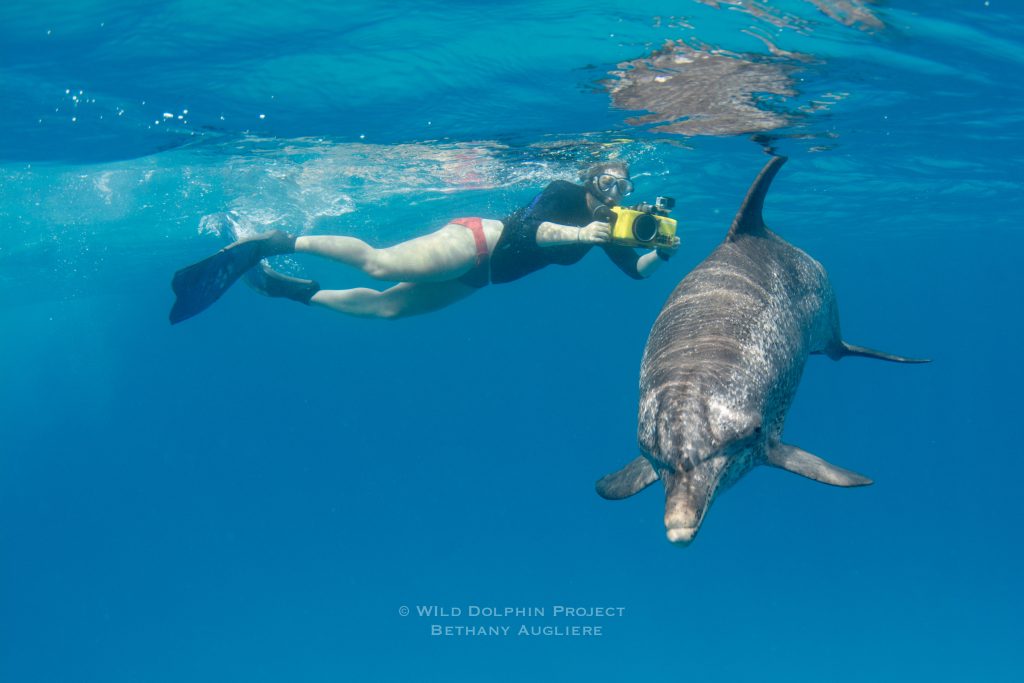
Cassie Volker with the recognizable yellow video camera to record underwater behavior and vocals.
What’s a typical day in the field like?
- First, remember we are living on a boat in the ocean to do this work! We get up at 6:30 am to get ready to start the day. Dolphin watch starts at 7 am and ends at 8 pm. A dolphin watch shift lasts for an hour, and we rotate with everyone on the boat. During dolphin watch we are looking for dolphins and recording environmental data (temperature, wind direction and strength, wave height, etc..). Aside from doing watches during the day, we are helping keep the kitchen clean and finishing up any data that did not get logged the night before.
- During the day, we hope to find dolphins. Once dolphins are spotted, the excitement begins. We compare our work in the field to being like a firefighter in the sense that nothing is happening until everything is happening! Once we spot dolphins we need to gear up and get cameras ready as quick as possible. Then we get in with the dolphins and document their behavior.
- Once the dolphin encounter is over, we write up what we saw and who we saw to be logged into the electronic databases in the evening.
- At the end of the day, we eat dinner and then review dolphin video and discuss it with the passengers, interns or colleagues on the boat. Then we enter data, sometimes late into the night, and then get up the next morning to do it all over again!
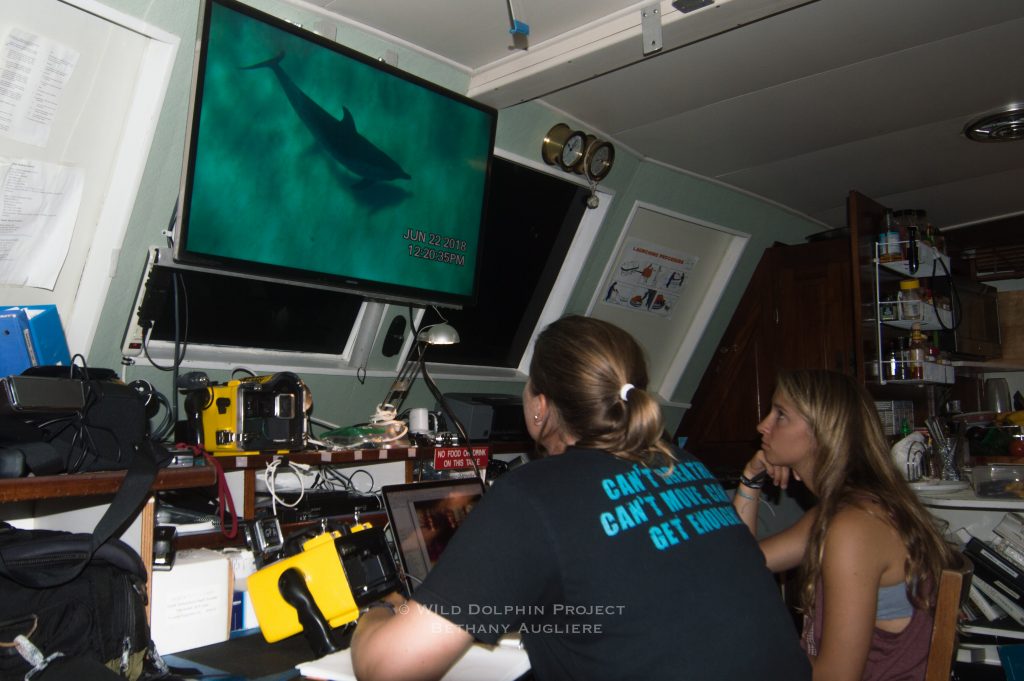
Watching the day’s video and logging what is happening for our electronic video database.
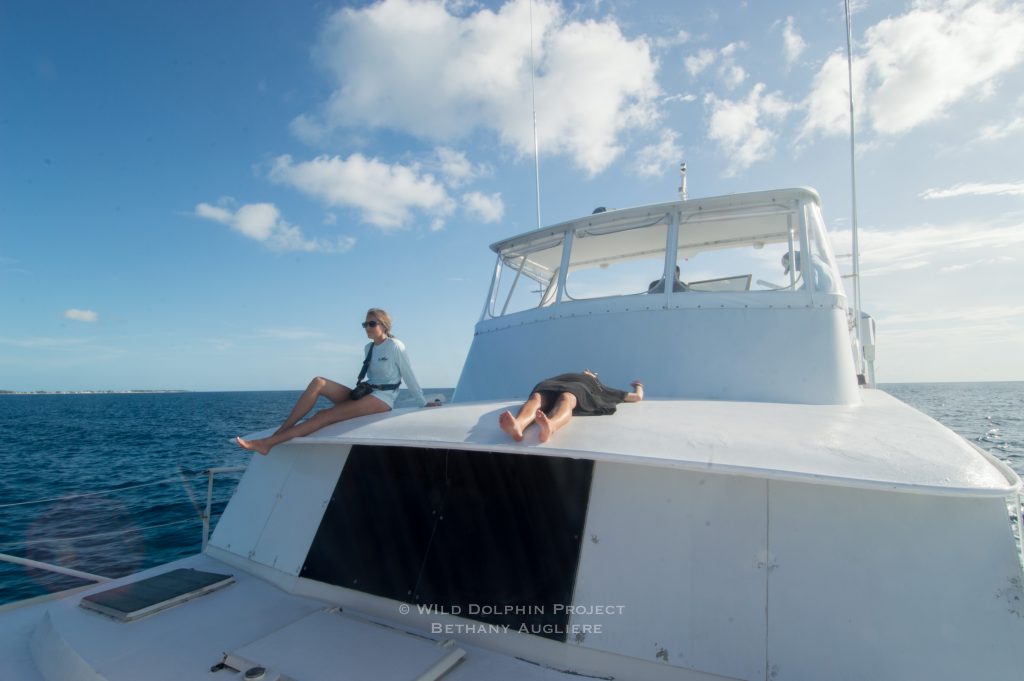
Looking for dolphins….the days can get long!
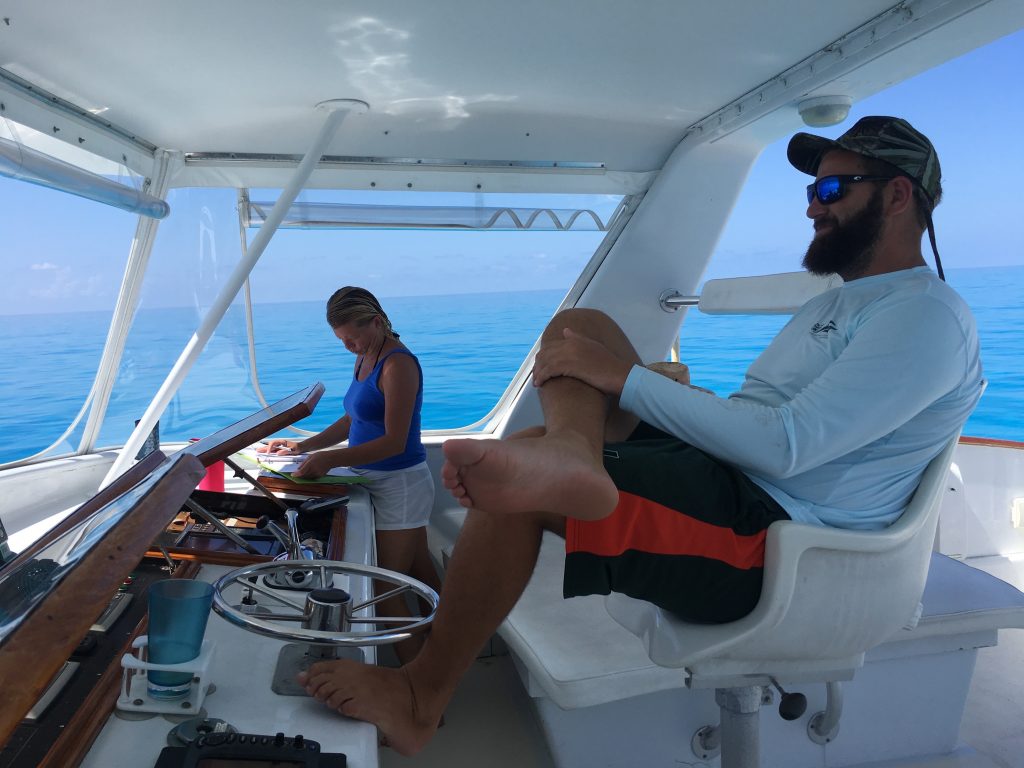
Dolphin Watch up on the bridge with the captain.
How long can dolphins live out of the water?
- The time they can live out of water doesn’t have to do with the lack of oxygen since they can breathe air. However, the limiting factor is the pressure gravity puts on their internal organs. When they are in the water they don’t have to worry about gravity. That’s why when they are being transported around, we have them on something soft and cushioned, or even elevated in a sling.
- Aside from the pressure on their organs, it is also the problem of drying out. If the dolphins are kept wet they can survive a couple of hours outside the water. But, they can dry out and get sunburn very easily if they are kept out of the water.
Are there other areas you would consider doing research?
- As of right now, we are pretty lucky and have the perfect spot for what we do. We have shallow water, calm seas and a resident group of dolphins habituated to human presence, which makes it easy (relatively speaking) to do our work. There are a lot of intricate behaviors going on underneath the surface that can’t be seen from above.
As of your 2019 season, how many new calves did you have in the community?
- We had 20 pregnant females and 10 new calves.
For more information:
- Check out NOAA’s fact-check on spotted dolphins and bottlenose dolphins.
- Learn more about our CHAT or two-way communication research with spotted dolphins, led by Dr. Herzing.
